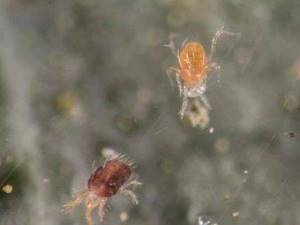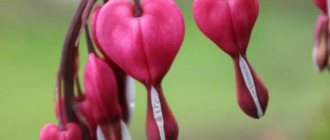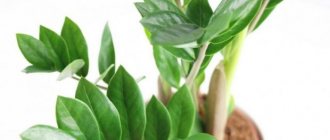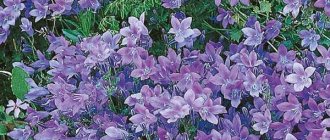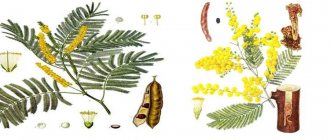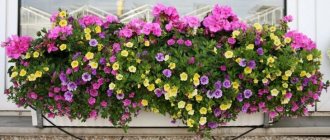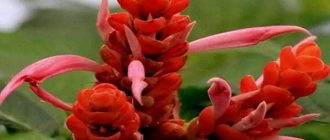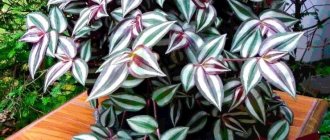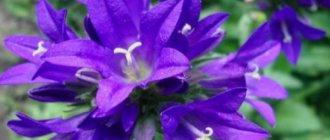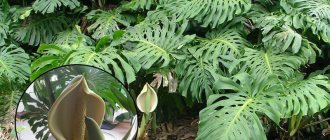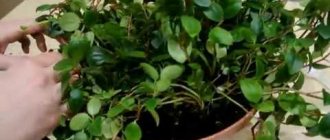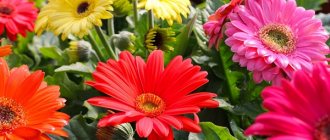Planting lobelias in open ground
Lobelia seedlings can be transferred to open soil only at the end of May, because this summer plant is very sensitive to returning frosts and low temperatures.
The optimal distance for planting is about 15 cm between the bushes. Lobelia can be planted closer in containers and ampels to achieve more aesthetic pomp.
When planting a plant, remember that lobelias are light-loving plants that bloom most beautifully in a sunny area (only certain hybrids and modern varieties are not afraid of diffused light or light shading). And after planting, the plants need constant, systematic care - abundant watering, compensating for even short-term drought.
This is a moisture-loving summer plant, in which complete drying of the soil causes a stop in development and flowering. The bushes are recovering, but without systematic watering it will be difficult to achieve the same impeccable beauty from lobelia. But lobelia needs feeding in literally minimal quantities (potted lobelias are fed according to the standard scheme - once a week, but in reduced doses, and in the ground lobelias need 1-2 procedures. And in order for lobelia to bloom tirelessly until the first frost, it will need help.
After flowering subsides, the plant needs to be pruned (or simply shorten individual faded shoots).
Lobelia. heyrehair
Lobelia care at home
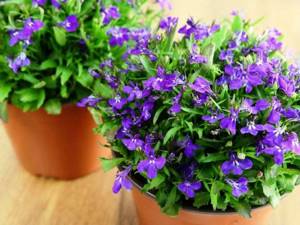
Lighting
Flowering will only be intense, long-lasting and bright when the plant receives enough sunlight. Lobelias in flowerpots are best hung on a loggia or balcony, or near a south window. However, you should not expose it directly to the sun. The light should be intense, but not leave burns.
Watering
Lobelia needs watering twice, in the morning and evening. But this only applies to really hot summer days. In order for the soil to retain moisture longer, it is enough to add sphagnum moss to it.
If the pot is in the open air, and suddenly it rains more often, then you should bring the plant under a canopy or into the house to avoid waterlogging.
Top dressing
Annuals take almost all the necessary nutrients from the soil. But once every two months they should be fed with floral liquid fertilizers. At the same time, ampelous lobelia blooms more profusely and retains vitality longer.
Sowing seeds
Lobelia ampelae is grown from seeds, which can be sown in containers or directly into the ground. Planting material must be fresh. It is most convenient to use granular options, covered with a special coating that not only protects small seeds, but also contains nutritional additives that improve germination. Translucent dragees should be placed in a nutrient substrate or peat tablets; even a child can work with them.
If it was not possible to purchase pelleted material, you can sow regular loose material. Lobelia seeds are very small, they are difficult to plant, for greater convenience they are mixed with sand. After germination, the seedlings will have to be planted in separate pots. This procedure requires some skill; young lobelias have very fragile roots.
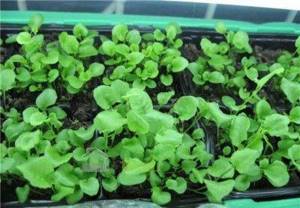
It is not difficult to understand how to plant an ampelous variety. Sowing of seedlings begins at the end of February or beginning of March, the exact timing depends on the climatic conditions of the region. Planting too early causes the stems to stretch due to lack of light, and lobelias can get blackleg and die.
For germinating seeds, ready-made universal soil, which can be purchased in the store, is suitable. Many gardeners prefer to make the mixture themselves, combining garden soil, previously calcined in the oven, with a generous portion of peat and a small amount of sand.
For seedlings, a shallow container with drainage holes or a tray is suitable. The seeds are scattered over the surface without being buried, the soil is generously sprayed with warm, soft water from a spray bottle. The container is covered with plastic film and placed in a well-lit place. The first shoots appear after 10 days. After this, it is necessary to regularly ventilate the seedlings, but the film should not be removed for a long time
For the successful development of sprouts, it is important to maintain constant soil moisture and bright lighting. When the daylight hours are short, it is recommended to illuminate the seedlings
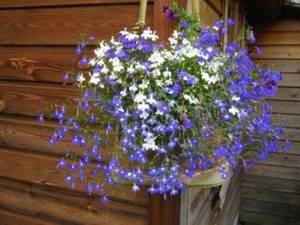
After 3-4 true leaves appear, the lobelia is planted, after thoroughly moistening the soil in the container. If the sprouts are intertwined with roots, you cannot forcibly separate them; it is better to plant the flowers in one pot. Peat cups and small containers made of paper or plastic are suitable. For better survival, the plantings are covered with film, which is removed after a few days. You need to water the seedlings very carefully, using a syringe without a needle or a teaspoon. Excess moisture on the surface can cause rotting of the stem and roots.
Before moving the seedlings to a permanent place, they are hardened off by taking them out onto a glassed-in balcony or opening the windows. On warm days, the pots can be left outdoors for several hours. After picking, the sprouts develop quickly; carefully pinching the tops will help improve branching.
Culture propagation
Lobelia from seeds
It may seem very difficult to grow lush lobelia using small seeds. Experienced flower growers recommend the generative method of propagation for beginners.
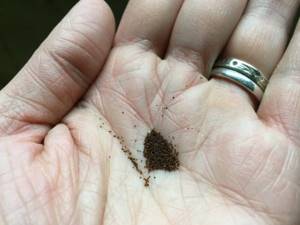
Small lobelia seeds.
To grow you need:
- Prepare a loose, light soil mixture. You will need to mix fertile soil, greenhouse soil, medium-grained sand and vermiculite.
- Seeds should be scattered evenly on the soil surface.
- You can gently press the planting material into the substrate.
- The container should be moved to a well-lit room with a temperature of about + 23 degrees.
- As the top layer dries, the mixture should be moistened.
- Seedlings can be damaged by the so-called black leg. For prevention, it is advisable to use watering with a weak solution of potassium permanganate.
- The first shoots will appear in 2 weeks.
- Lobelia should be fed with complex fertilizer for indoor crops.
- The size of small seedlings allows the plant to be planted in groups into one container.
- To create a fluffy cap and a dense shape, you should regularly pinch the plant.
Cuttings
To propagate, you will need to cut several strong stems from a healthy lobelia. It is advisable to carry out the procedure in early spring.
For rooting, you can use phytohormones or honey. The treated cuttings must be placed in a prepared moist substrate.
To create greenhouse conditions, you can use a cut plastic bottle or transparent film. Increased humidity levels will shorten rooting time. It is not recommended to place the container in direct sunlight. The seedlings may turn black or dry out.
To ensure air circulation, you will need to ventilate the container periodically. In a month the cuttings will take root. Young plants can be taken outside after 1.5 months.
The flower must be watered regularly. Once a week you should feed a new crop and clean it of dried inflorescences.
The best types and varieties of lobelia: photos and descriptions
The best varieties of lobelia can be viewed on this page with detailed descriptions and accompanying images. The culture is divided into types and varieties of lobelia, which have very different purposes. Lobelia erinus prostrata has shoots 15–30 cm long, and the height of the bush is small (up to 15 cm). The upright form of lobelia of the same species reaches a height of 15–25 cm. Dwarf lobelia erinus differs in height - only 8–12 cm. In compact lobelia erinus, the bushes grow up to 15–20 cm in height and spread less in width.
The following are the most popular varieties of lobelia with photos and descriptions that will help you choose suitable plants for your garden plot.
The most revered varieties of Lobelia erinus are compact plants.
Among them, the variety Crystal Palace stands out
This plant has very beautiful bright blue flowers, and the leaves on young plants appear black in summer.
The Kaiser Wilhelm variety is distinguished by its pronounced branching bushes.
As a result, they close together and look like a continuous carpet. The flowers of this variety of lobelia are light blue in color.
The White Lady lobelia variety has white flowers.
Varieties of dwarf lobelia have red and dark blue flowers with a white center.
There is a rare form of Lobelia erinus with double flowers. They come in white, blue, purple and pink.
Lobelia erinus Crystal Palace.
This is one of the best dwarf varieties. A beautiful plant with dark green foliage, completely strewn with blue flowers, a bush 10-15 cm high. Blooms from June to September. The place is sunny, the soil is loamy with the addition of organic fertilizer. Seeds are sown in February.
Hybrid varieties of lobelia have longer branches.
They are grown as hanging plants in hanging pots. Lobelia with hanging branches is often planted on balconies and along the walls of buildings.
Plants of the Amanda variety are distinguished by red flowers with a white center or pink-purple.
Lobelia variety Miranda has pink-purple flowers with a white center.
The Sapphire variety has dark blue flowers with a white eye.
Another type of lobelia is lobelia lucidum.
This plant is taller (60–90 cm) compared to Lobelia erinus. It is a perennial and has dark green leaves with a reddish tint. The flowers of this type of lobelia are bright red. This plant, unlike lobelia erinus, propagates not by seeds, but by cuttings.
The most popular varieties of brilliant lobelia are:
Victoria
Illuminations
Lobelia climbing red cascade is a hanging plant up to 30 cm.
The plant is covered with purple-red flowers with a white center. Blooms from June to September.
Lobelia climbing white fountain is a hanging plant 30 cm high, strewn with pure white flowers.
Look again at all the presented types and varieties of lobelia in the photo, which illustrates the distinctive external characteristics of the flowers:
Lobelia in flower beds is combined with yellow mimulus, red pelargoniums and brilliant salvia. At close range the plants look most attractive.
Lobelia is suitable for creating borders, mixborders, arabesques and carpet beds.
It is also planted in rock gardens, near ponds. Ampelous varieties of lobelia in hanging flowerpots are used to decorate balconies and verandas.
Blooming lobelia, planted in one or two rows, forms a continuous ribbon and is often used to create narrow borders and patterns.
Botanical description and popular varieties of culture
Lobelia is a perennial flowering plant. There are more than 300 species forms, but only 2-3 dozen species are offered for garden cultivation.
Campanula family. The place of growth, the birthplace of the flower is the African continent (southern side). Can also be found in subtropical zones.
In nature, lobelia prefers rocky soil and loves high humidity. At home, the flower changes its preferences and becomes an annual crop.
External data:
- shoots: thin and flexible:
- highly branched;
- abundant green mass:
- the bush has the shape of a ball or column;
- height: depends on the shape. From 15 to 40 cm.
Since there are many types of lobelia, there are also creeping ground cover forms. In such species, the stem is longer: 10-40 cm. If we summarize the biological indicators, lobelia is a plant with spiral-shaped small leaves. The foliage is also characterized as sessile lanceolate. Serrated edges.
The flowers are solitary axillary, diameter – 2-3 cm. The color of the flower is varied. The most popular colors: all shades of blue and light blue, pastel colors. There are types of white, pink and crimson colors of varying intensities.
Flowering is long lasting. Start: June. Completion: September-October.
Need to know! Lobelia can be grown in literally all climate zones. You just need to know exactly which varieties are resistant to frost and sudden temperature changes. These include: Lobelia Strong, Ricardi ampelous, Erinus, Gerardi, Fiery.
Dwarf
The lobelia species is highly branched. Height: 10-20 cm. Inflorescences are small, no more than 1-2 cm in diameter. Color: all shades of blue, purple, pink. There are white hybrid forms.
The species is represented by two types: ampelous and regular. It takes root and develops well both in the shade and in the sun. The main condition: moist soil.
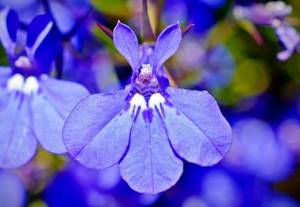
Compact
Lobelia compacta is popular for its unique qualities. Suitable for growing in the garden, on the balcony, in flower pots. Will become a decoration for flower beds and flower beds. It has long, abundant flowering. There are several types: ampel and cascade.
The group included about 10 varieties. Mainly blue and its shades. Height ranges from 8 to 15 cm.
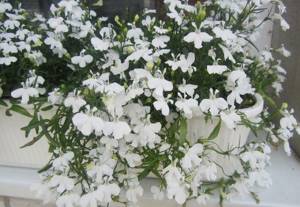
Erect
This type of lobelia is distinguished by its height. Quite long flowers: up to 75 cm.
They love high humidity, so in the wild they grow near ponds and wetlands. Mostly red. There are two varieties of erect lobelia: Fulgens and Cardinal.

Ampelous or climbing
Differences: very long, drooping shoots. Recommended for pots, home (indoor) flower beds. There are three varieties that are the strongest and most resistant to temperature changes:
- white color - Curacao Basket;
- blue flowers with a white eye - Curacao Blue;
- heavenly color with a white eye - Technohat Trailing Light Blue.
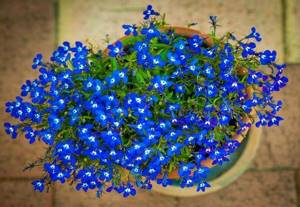
About pests and diseases
When perennial lobelia is outdoors, it may also be attacked by pests. Aphids carried by ants are considered extremely annoying.
ampelous lobelia
In some cases, it is not so easy to understand who exactly is harming the plantings. For preventive purposes, you can use a complex pest control product called “fitoverm”. This is what has the maximum effect.
The ampoule is diluted according to the instructions. If the solution is in excess quantity, then you can safely treat other plantings with it.
But not only pests can cause damage to the plant and cause lobelia to feel unwell; various diseases also do not lead to anything good.
If yellow leaves suddenly appear and begin to fall off, it is recommended to dispose of them by fire in order to prevent the unknown infection from spreading throughout the area.
Let's sum it up
Not every novice gardener believes that a plant can act as a decoration for a site. This impression especially often occurs when you first meet lobelia. But many people have already appreciated the decorative qualities of the shrub.
Growing lobelia in open ground should not pose any difficulties if all the rules are followed, which apply not only to ampelous varieties.
Caring for summer lobelias
The most difficult thing about growing lobelias is maintaining constant soil moisture. Lobelias are not afraid of droughts, but at the same time they quickly lose their bush shape and instantly stop flowering. They will never be able to recover and will look like ordinary, unremarkable crops with sparse flowers and twisted, elongated shoots
Therefore, increased attention should be paid to watering. The roots and substrate should not be allowed to dry out completely, even for 1-2 days, so watering lobelias should be frequent and plentiful.
It is better to drain the water from the pan after watering than to underfill it. Watering is equally necessary for lobelias growing in pots and for those planted in open soil.
Fertilizing for lobelias is carried out in accordance with the plants’ not too great love for nutritious soils. Fertilizers are applied periodically, along with abundant watering, just maintaining stable soil characteristics. Typically, for lobelias, feeding is carried out half as often as for other annuals - once every 2 weeks or weekly, but in reduced doses.
For beauty and lush flowering, lobelias need pruning. The thing is that lobelias bloom in waves and to constantly maintain abundant flowering they need help. From lobelias, shoots that have already completed flowering are removed, cutting them off at a height of about 5 cm. This summer plant very quickly and actively grows new greenery and the next wave of flowering occurs literally in a matter of days. But do not rush to prune: in many new varieties the second wave begins on its own without stimulation, and if your lobelia does not show signs of ending flowering and tirelessly flaunts a blanket of flowers, then there is no point in pruning it. Watch the plant and it will tell you the best strategy.
If the shape of the bush is important to you, and some shoots are knocked out of the crown, then it is better to pinch the tops and thereby stimulate the thickening of the bush.
Lobelias are not afraid of pests and diseases. If they are surrounded by infected plants or you have allowed the soil to become waterlogged, the plant has suffered greatly, then it is better not to fight the source of infections, but simply destroy the entire plant and replace it with a new one.
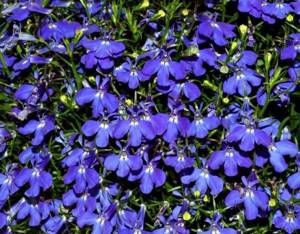
Lobelia erinus, or Long-petioled Lobelia (Lobelia erinus). pacificgreenlandscape
Application in design
The lobelia flower will be a magnificent decoration for a balcony, loggia, or veranda. It is not difficult to understand how to plant plants so that they look as decorative as possible. Usually they are selected according to shades, and several bushes are placed in one pot. White lobelia looks very beautiful, complemented by flowers in pink, blue or light lilac tones. This composition can be placed against a background of dark wood or red brick walls.
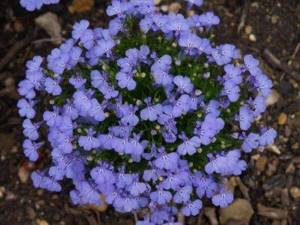
Lobelia ampelous Sapphire goes well with two-color options. The bluish-white Emperor Willie will be a good neighbor. The number of flowers depends on the size of the pots. A spacious basket will accommodate several pieces at once; 2-3 stems are planted in a medium-sized pot.
A multi-tiered structure in which both ampelous and bush forms of lobelias are planted will help to decorate the balcony. A smooth transition of shades will create a spectacular composition that can be moved to any convenient place.
Blue lobelia looks impressive against a background of greenery. It can be planted near a low support or hung on a tree branch in a wicker basket. A plant with white flowers will help complement varieties with sky-blue buds. You should not combine lobelia with other hanging plants; it only gets along well with representatives of its own species.
https://youtube.com/watch?v=RZPuy6GHVlg
The flower is suitable for decorating rock gardens. It is planted in the first row; ampelous vines will spread along the ground, creating a gentle background for taller plants. Lobelia combines beautifully with alyssum, silver wormwood, pelargonium, edelweiss, and pansies. In the background you can plant thuja, bamboo, bearded iris or rudbeckia
It is important to choose the right shades, achieving smooth transitions or effective contrasts
Lobelia, planting and caring for it is an interesting topic for novice gardeners. Dosed watering, fertilizing and pruning will allow you to form elegant, lush bushes that will decorate your balcony, veranda or recreation area at your summer cottage all summer long.
Forms, types, varieties of lobelia
Only Lobelia erinus is grown as an annual flower. This plant has thin herbaceous shoots and jagged leaves. Lobelia has a lot of stems, because of this, an adult plant looks like a ball with leaves and a large number of small flowers of ultramarine, shiny purple-pink, cornflower blue, heavenly, snow-white, violet shades.
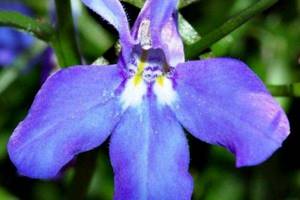
Forms of Lobelia erinus
There are 5 forms:
- Compact - the stems stand straight, they are 10-15 cm in height.
- Spreading - has long, spreading shoots, their length is up to 30 cm, although the height of the bush is 15 cm. Compact and spreading forms look great in flower borders.
- Dwarf - it is only 8-12 cm in height.
- Erect - resembles a column, grows up to 25 cm.
- Ampelous - it grows long shoots up to 30-35 cm, they hang down like a cascade. The ampel shape looks great in flowerpots, hanging baskets, and drawers on the balcony.
Varieties of Lobelia erinus
Bush:
- “Crystal Palace” - 15-18 cm in height. The plant has many violet-gray and cornflower blue flowers.
- "Emperor Willy" - stems up to 10 cm with azure-gray flowers. The photo shows that in open ground, lobelia looks like a blooming cloud.
- "Miss Klibran" - up to 10-15 cm. Flowers - violet-blue, have a white eye.
Ampelous:
- "Sapphire" - has many drooping lashes, 25-35 cm long. The flowers are dark blue, have white spots on the lower petals.
- “Blue fountain” - a large number of hanging stems; in the photo it looks like a cascade of green leaves and light blue flowers that have white eyes. The length of the shoots is 30-35 cm.
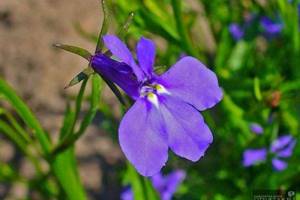
lobelia erinus
What you need to know about transplanting into open ground
Plants need to be acclimatized before they are planted outside. To do this, containers with seedlings are taken out into the fresh air, placed in the shade for a while, and then transferred to a sunny area. You can start planting in the last days of May, at which time the threat of night cold has already passed.
It all depends on the variety:
- shrubs – 25 cm;
- cascading, used as ground cover plants - 20 cm;
- hanging types for flowerpots and hanging flower pots – 15 cm.
Lobelia does not need very fertile soil, because... the green part begins to grow abundantly in it. As for flowering, it will be very weak, which is why the decorative effect of the shrub is lost. An area with a high humus content is selected, which will provide the seedlings with useful nutrients.
Useful tips for improving the flowering of ampelous varieties
- It will take some time for the seedlings to take root in their new location. Once this happens, it is recommended to pinch by simply breaking off the top of the plant. Thanks to this procedure, the shrub will develop evenly in height and width.
- After the first flowering has passed, it is time to shorten all shoots by 5 cm. This helps the lobelia to recruit new branches and the reappearance of flowers.
Planting lobelia seeds in the snow
Take a suitable container and fill it with soil for seedlings.
It is desirable that it be peaty, very loose, airy, with the addition of perlite and sand.

We moisten the soil quite a bit on the surface.

We spread about 2 cm thick snow collected from the street on top of the ground.
Snow will help us to easily stratify the seeds, and melt water will very well moisten the substrate for future sprouts.

Next, we simply scatter the seeds over the snow, as if we were salting soup.
Or you can scoop lobelia seeds onto a damp finger and leave them on the snow.

Next, simply close the greenhouse and place it under lighting or in the brightest place.
The temperature for germination should be 23-25 degrees.

On days 5-8, shoots will appear.

Here's a method, take note. It is very comfortable and showed excellent germination!
But not all regions have snow in winter.
Therefore, we have prepared a second method for you, which will also help you successfully sow and germinate lobelia.
Briefly about 5 features
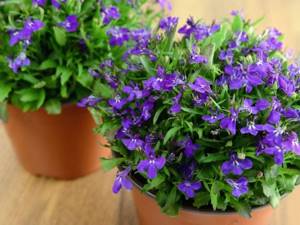
Miniature upright bushes look great on window sills. Photo: fb.ru
- Affiliation. Lobelia (lat. Lobelia) is a herbaceous plant belonging to the bellflower family, although now a number of scientists distinguish it as a separate species called lobeliaceae. Named after the Dutch botanist Matthias de L'Obel (1538-1616), who described it.
- Origin. The debate about the origin of this species continues to this day; it is officially believed that the flower comes from the subtropics, but, for example, in Russia there are 2 wild varieties - Lobelia dortmanna and Lobelia sessilifolia.
- Lifetime. The flower is perennial, but Russian latitudes have their own peculiarities of growing lobelia; due to the climate, it is cultivated in open ground as an annual.
- Characteristics. There are about 300 varieties of plants, the height ranges from 15 cm to 1.5 m. The crown of the bushes is dense, branched, and consists of thin stems. Leaves are lanceolate, highly elongated. Flowers are axillary, two-lipped, bud size up to 2 cm.
- Reproduction. To obtain early flowering, the crop is planted with seeds for seedlings; cuttings are used to preserve the characteristics of the variety. You can also propagate by dividing the bush, but this method is used extremely rarely.
For hanging, it is advisable to choose ampelous plant species
The video shows in detail the cultivation of lobelia from seeds in seedlings, followed by double diving and pinching the seedlings to stimulate growth.
Growing lobelia on the balcony
Many people decorate their balconies with lobelia. Familiar window sills “come to life” from such guests. Typically, the following varieties are used for growing on balconies:
- Cardinal;
- Rosamund;
- Syphilitic;
- Blue fountain;
- Dortman;
- Fiery.
The varieties described above are low-growing and densely growing - an excellent option for decorating balconies and loggias. Seedlings are planted in permanent pots, cache-pots or containers.
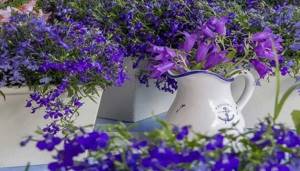
They dive into light and nutritious soil when the plants reach about 4-5 centimeters in height. It is convenient to replant them with a spoon, picking up the plants along with the soil. Leave about 4 centimeters between the shoots and tamp them down a little.
When they grow to 8 centimeters, the tops are pinched - we will talk about this below.
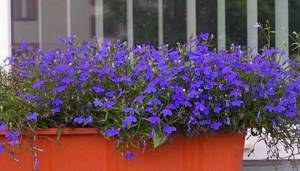
Seedlings can be transplanted onto an uninsulated balcony when the temperature outside the window remains within +15 degrees. Lobelia can withstand a one-time drop in temperature down to -2 degrees. This will not cause any problems, but only within one day.
In cloudy weather and short daylight hours, you need to highlight the sprouts. But, despite their addiction to light, direct sunlight should be avoided, especially through glass - they can die. The most ideal temperature for flowering is 25 degrees Celsius.
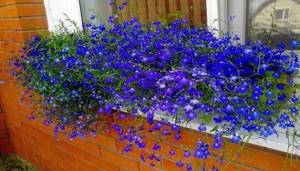
Since this species loves humidity, it needs to be maintained at 50-60%. They need to be watered every day. At the same time, you cannot overfill. Water should be absorbed into the soil without leaving any residue. On a particularly hot day, it is better to water them twice – in the morning and in the evening. Be sure to make holes at the bottom of the pots for ventilation and release of excess moisture.
Watering is carried out strictly under the root. Droplets of water on a plant on a hot sunny day can cause severe burns. It is better to fertilize the plants on the balcony 2 times a month with mineral substances for flowers, according to the instructions. At the same time, it is better to avoid fertilizers with a high nitrogen content. In excess, it leads to slower growth.
Secrets of caring for seedlings
You need to know some secrets that will help you grow healthy and strong seedlings. First you need to monitor the temperature in the room where they will grow. At first it should be +20-22 degrees. And after you see the first borings, the temperature should be reduced to +15. It is enough that you transfer them to the windowsill. This change comes 7-10 days after they were sown.
While the seeds are germinating, you need to ensure that the soil is constantly moist. You should also remember to remove condensation from the film and ventilate it. But this needs to be done gradually, since if you immediately remove the film, the seeds may die within 24 hours. Only, only when they grow 1 cm will it be possible to completely remove it.
As for the light, in winter they do not have enough of it and you will have to provide the ampelous lobelia with additional lighting. If this happens in the spring, then it will not be needed here. Especially if you put them on a windowsill that is on the south side.
Watering is considered the most difficult stage in caring for seedlings and it causes many difficulties. It is impossible to water with a sprinkler, because the water gets on the thin, immature seedlings. They fall to the ground under the weight of the water and never rise again. You need to water so that water does not fall on the plants, thereby protecting it from a whole list of diseases.
To do this, indentations are made between all the bushes using a regular pencil. And then water is poured in using a syringe. The earth itself distributes the liquid evenly over the entire surface. So you need to water for 2-3 weeks until the sprouts get stronger. Growing lobelia seedlings is not difficult at all and even a beginner can handle it.
Picking and hardening
Picking lobelia is the most pleasant procedure. First you need to water the seedlings well, but not overwater them. Then take a small plastic spoon and carefully separate the bunch of ampelous lobelia. Plant in a prepared container containing a light potting mix. For the first few days after picking, keep the containers in the shade and water them well.
Then we begin the hardening procedure. It is a mandatory process. To do this, you need to have a sunny side and take the container with young seedlings there. Already in March, you can begin to harden the plant, just at low temperatures and bright lighting. You need to put it back at night. On cloudy days additional lighting is needed.
Bedding
Before planting in the ground, you need to decide on the location. This plant does not require much attention and care. The soil should be loose and breathable. Water should not stagnate there. The land also should not be too fertile, otherwise the lobelia will have a lot of greenery, but few flowers. It also does not need fertilizing with nitrogen fertilizers.
Watering should be moderate and without waterlogging. The main thing is that the soil is slightly moist. It grows great in the sun, but it will do well in a place where the sun shines for several hours. Ampelous lobelia will bloom until frost.
The planting itself in the ground occurs at the end of May, when the frosts have passed and the soil has already warmed up a little. We plant about four lobelias in each hole. The distance between the holes should be 10-15 cm.
Lobelia: growing from seeds
Sowing lobelia
It all starts with sowing. Select any suitable container: seedling cassettes with trays, plastic containers for confectionery, egg trays, plastic cups, wide bowls, etc.
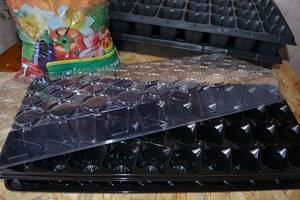
Cassettes with a transparent lid are an excellent choice for sowing lobelia seeds
Fill the container with soil. Purchased soil for seedlings or universal peat-based soil is suitable. Instead of soil, you can use peat tablets, which perfectly retain moisture and contain nutrients that allow seedlings to develop faster than in regular peat soil.
To disinfect the soil from pathogenic fungi and microorganisms, it is spilled with boiling water. For greater effect, add a couple of crystals of potassium permanganate to the boiling water, then the infection will no longer have any chance.
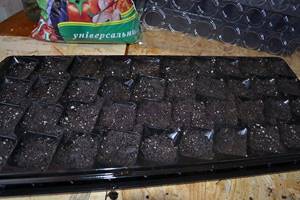
Filling the cassette cells with soil for sowing lobelia
Seeds are sown on moist, cooled soil. They do this superficially, without embedding it into the soil. You can use the following options for planting lobelia seedlings:
- Since lobelia seeds are very small, you can mix them with sand, and then “salt” the earth with this mixture. This method allows you to evenly distribute the seeds over the surface.
- There is another option. A moistened toothpick is dipped into the seeds, and then transferred to the soil in small groups of 5-10 seeds. The distance between groups is 2-3 cm. Planting of lobelia for permanent residence is carried out not with single plants, but with such bunches. Therefore, the initial “group” planting makes it possible to facilitate picking and reduce its traumatic effect on the sprouts.

Lobelia seeds are sown on the surface of the soil (in the photo - sowing multi-drags, each of which contains several lobelia seeds)
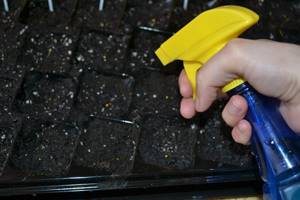
Then the crops are covered with a transparent material - a plastic lid, film, sheet of glass or polycarbonate.
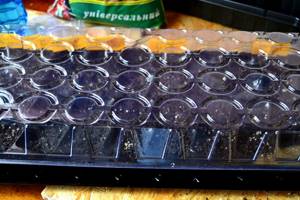
A moist, stable microclimate is formed under the lid, promoting rapid germination and development of lobelia seedlings
How to sow lobelia from seeds at home, watch the video:
Lobelia seedling care
Lobelia shoots from seeds appear 5-10 days after sowing.
While the seedling container is covered with a lid (film, glass), every day it is necessary to wipe off the condensation that has accumulated on it to reduce excess humidity. Also, open the lid and ventilate the soil and seedlings. At least 10-20 minutes in the morning and evening. These measures will reduce the likelihood of the appearance of white mold and “black leg”, which can mow down all the seedlings in a day.
When the sprouts are a little stronger, the lid can be removed from the container. But this needs to be done gradually. Accustomed to morning and evening ventilation (10-20 minutes each), lobelia seedlings will almost certainly tolerate a longer stay in the air well.
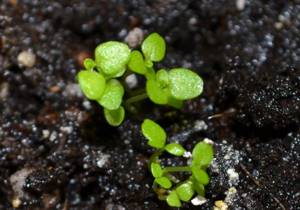
This is what lobelia sprouts look like at 2 weeks of age (3 weeks from sowing)
After removing the lid from the lobelia seedlings, you will have to water it frequently. And make sure that the soil does not dry out, otherwise the sprouts will die in a matter of hours. As soon as you notice that the surface of the soil has hardened slightly, water it immediately! The root of lobelia is small, while that of its seedlings is generally tiny and is located in the top layer of soil. As soon as it dries out, the root comes to an end, and with it the small plants.
As a rule, lobelia is not fed during the seedling period, since it is not particularly voracious. As a last resort, you can introduce fertilizing for month-old seedlings using universal fertilizer. The fertilizer concentration is 2-3 times weaker than recommended for adult plants.
As soon as the temperature on the balcony (veranda, street) stabilizes at 10-15°C, you can take the seedlings out for a walk, that is, harden them in the fresh air. At first, place the seedling containers only during the daytime, and then (if night frosts are excluded) - at night.
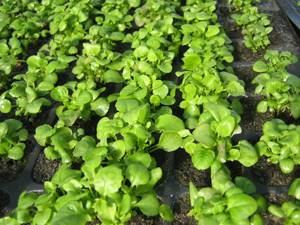
The most important thing for lobelia seedlings is plenty of light, fresh air and regular watering
And now - a small list of rules that will allow you to grow strong and healthy lobelia seedlings:
- Watering. Lobelia at home does not tolerate drying out, just like the bay. The top layer of soil should not be allowed to dry out (we are talking about sprouts 1-2 months old, adult plants are much more resistant). You also cannot constantly keep water in the tray of the planting container and create a swamp in the soil.
- Lighting. An important condition for seedling growth is bright, diffused lighting. Lobelia from seeds in infancy is very capricious; direct sunlight can easily kill it. Therefore, only diffused light or oblique sunlight combined with abundant watering. Seedlings can be shaded from the bright midday sun with a curtain, newspaper, or dense mesh.
- Fresh air. Lobelia seedlings should be accustomed to fresh air as early as possible and taken out onto the balcony (street).
Picking lobelia seedlings
It is not necessary to plant sprouts sown in cassette cells or cups. Lobelia calmly survives until landing in a permanent place and without transplantation. The need for picking arises when sowing seedlings in a common container. Neighboring sprouts are intertwined with stems, leaves and roots, so they must be planted at the stage of approximately 2-3 true leaves. Lobelia sprouts are picked in bunches of 5-10 plants, each bunch in a separate container.
If the sprouts are distributed evenly in the planting container (and not in groups), then the turf is cut into pieces with a knife or scalpel so that each piece contains 5-10 plants. Then each piece is grabbed with a tea (coffee) spoon and transferred to a separate container. Lobelia suffers almost no damage to the root system and tolerates such a transplant well.
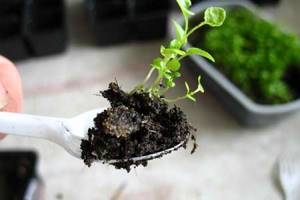
It is convenient to transplant a group of lobelia sprouts from a common container using a teaspoon
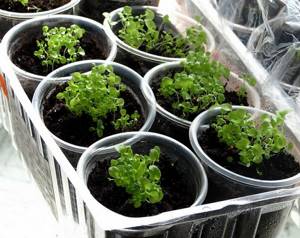
Pickled lobelia sprouts in separate cups
The process of picking lobelia sprouts is recorded on video:
Pinching lobelia seedlings
This procedure is also optional. But it allows the lobelia bushes to grow more branched and fluffy. This is especially desirable if there is still a lot of time left before planting for permanent residence and the seedlings are outgrowing. Pinching (or cutting) is performed when the lobelia sprouts grow to 3-4 cm.
Planting lobelia seedlings for permanent residence
Already grown mature lobelia seedlings are planted for permanent residence in balcony boxes, flowerpots, hanging baskets or in open ground. This is usually done in the second half of May, when the threat of night frosts has passed.
Planting lobelia is carried out according to the same principle as picking - in groups of 5-10 plants. The distance between the bunches is 15-25 cm. On average, each bunch should contain 1 liter of soil.
Since lobelia prefers bright but diffused lighting, a place for planting it should be selected in semi-shade. Direct morning or evening sun rays in small quantities are acceptable; shading from midday rays is necessary. Therefore, lobelia feels good on western and eastern balconies. Northern ones - open and bright - are also suitable.
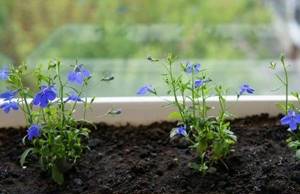
Lobelia seedlings in a balcony box - in a month the bushes will grow and merge into one blooming cloud
Caring for a plant in open ground
For those who want to grow a beautiful flower, you need to follow some rules
You should pay special attention to watering the plant, since not only the appearance, but also the duration of flowering depends on it. Also, before planting and starting to care for lobelia, you need to know where it is best to place it and what means to fertilize it
Lighting
Try to protect your flower from direct sunlight, as burns will appear on the leaves of the plant. Lobelia prefers bright, diffused light. Fertilize with mineral fertilizers in a timely manner. Prune plants after flowering to encourage new growth.
Irrigation
First of all, it is necessary to ensure regular moderate watering, but at the same time you need to ensure that the water does not stagnate. If the soil dries out, the plant may quickly stop blooming. To ensure that the bush is lush and spherical, pinch it in a timely manner. They do this after the culture has already adapted to new conditions. Remove the tip of the branch, and then the top will grow outward.
Trimming
When the first flowering has passed, trim the lobelia branches, retreating from the top to five centimeters. Over time, you will see new shoots at the cut site. Before frost, cut the bush almost to the root itself, and cover it with fallen leaves on top. There are varieties that cannot tolerate extreme cold, so replant the plants in pots and bring them into a warm room.
Fertilizer
Many people don’t know what to feed lobelia to grow. It's actually simple. You can use ordinary universal preparations as fertilizer. The frequency of application depends on the composition of the soil. The plant is fertilized up to three times throughout the entire season. You can also use ready-made mineral compositions that contain phosphorus, calcium and nitrogen.
Possible pests
To the delight of gardeners, lobelias are very resistant to various diseases and pests. The only exceptions are slugs, which attack plants grown near bodies of water. In addition, if there is an excess of moisture, they can become moldy, so you need to be careful when watering.
In order for the plant to feel good on the site and give it a special charm, you need to know what to plant lobelia with. The best options are allisum and iberis. Petunias, begonias, ageratums will also make an excellent composition.
The process of growing and caring for lobelia is quite labor-intensive. But don’t worry, if you stick to simple recommendations, these plants will undoubtedly become one of your favorites.
Types of lobelia perennial
The following types of lobelia are distinguished:

1.Long-petiolate. Perennial plant with dense foliage and flowering. It has a spherical shape and is often used for decorating borders. The bush is small - up to 25 centimeters. The flowers are about a centimeter in diameter. Also called erinus.
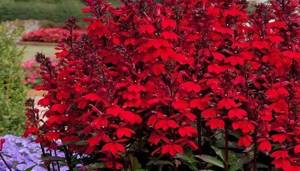
2.Beautiful. Relatively long-growing trunks for this species. They reach a length of up to 90 centimeters. From the end of June to September they bloom with tubular flowers that reach a diameter of no more than 3 centimeters.
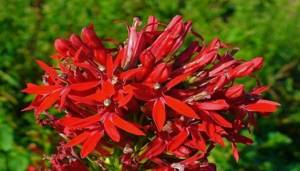
3.Purple. It is also called cardinal's. A very beautiful and spectacular bush. Most often they are grown on damp ground, for example, around ponds. The plant is a bush, about 90 centimeters high, with scarlet flowers rising above the leaves, collected in a spikelet.
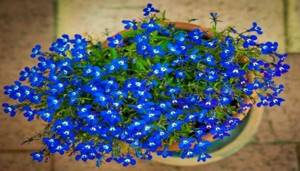
4.Blue. This plant is perennial. Blue or purple flowers bloom at the end of July and delight the eye until autumn. This bush grows to almost a meter in height.
Today we will look in detail at how to plant and grow lobelia with your own hands.
Possible problems
Although lobelia is a disease-resistant crop, non-compliance with care rules reduces the immunity of seedlings, which become vulnerable to pathogenic microflora and harmful insects. The most common reason for the development of infections of fungal etiology is a violation of the irrigation regime.
When the soil is excessively waterlogged, moisture begins to stagnate in it, which creates favorable conditions for the appearance and proliferation of fungi. Their presence is evidenced by characteristic dark spots covering the shoots and leaves of the saplings. Treatment consists of removing the affected parts of the seedlings and then treating all sprouts with biofungicides.
Among the pests, the greatest threat to lobelias is phytophagous spider mites. To get to the cell sap, these small sucking insects damage the green parts of the plants, as a result of which they begin to wither and shed their leaves. Dry conditions favor the emergence of phytophages. If the seedlings are slightly damaged, it is necessary to increase the frequency of watering and spray them using a solution of soap shavings.
